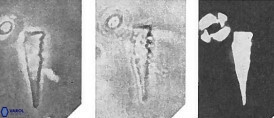Triamutilaferrum martinii
(Gartner, 1967a)
Varol, n. comb.
Feb 27, 2021
Set number: 476
-
1
-
2
-
3
-
4
-
5
-
6
-
7
-
8
10µm
Final Epithet
Triamutilaferrum martinii (Gartner, 1967a)
Varol, n. comb.
Basionym
Triquetrorhabdulus martinii Gartner, 1967a
Synonyms
Triquetrorhabdulus sp. Martini, 1965, p. 408, Pl. 36, Fig. 6
References
Bramlette, M. N. & Wilcoxon, J. A. 1967. Middle Tertiary calcareous nannoplankton of the Cipero section, Trinidad, W.I. Tulane Studies in Geology and Paleontology 5: 93-131.
Gartner, S. 1967a. Calcareous nannofossils from Neogene of Trinidad, Jamaica, and Gulf of Mexico. University of Kansas Paleontological Contributions, Papers 29: 1-7.
Martini, E. 1965. Mid-Tertiary calcareous nannoplankton from Pacific deep-sea cores. Colston Papers 17: 393-411.
